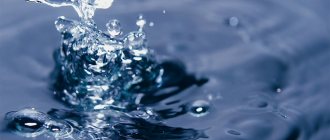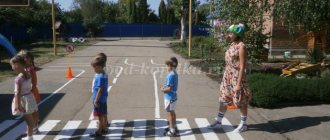Water in different states
Goal: to create conditions for children to become familiar with the properties of water. Objectives: Educational: introduce the properties of water: fluidity; the ability to dissolve bulk substances; the ability to take shape and move from one state to another; learn to conduct simple research; learn to look for answers, assume, draw conclusions; developmental: promote the development of children's creative research activity; develop coherent speech; educational: to develop the ability to work in a team, respect for water. Health-saving technologies: eye exercises, physical education, games. Interactive technologies – lesson presentation.
Source
Experimental research project “Water Sorceress”
Experimental research project “ Water in the Enchantress”
in the older group of compensatory orientation.
Project
passport 1. Type
of project
: research - creative.
2.Duration:
medium duration (2 months)
3.
Project
participants :
children of the older group of compensatory orientation, in
caregiver
4.Explanatory note.
Relevance of the topic:
Walking outside with the children in the fall, the children began to look at the puddles and became interested in the question of what kind of water
.
What happens to it in nature. We decided to understand the properties of water through experimentation. What properties does the sorceress – water –
?
The project was developed due to the particular relevance of the problem of educating preschoolers’ environmental culture.
The ecological state of our planet and the tendency towards its deterioration now require living people to understand the current situation and have a conscious attitude towards it.
The progressive deterioration of the health of adults and children is facilitated by various pollution of soil, water and air, as a result of which people eat poor-quality foods, drink bad water, and breathe air with a large admixture of exhaust gases.
The modern content of educational work with preschool children involves the humanization of the entire pedagogical process. A huge role in organizing this problem is assigned to the environmental education of children. Today, environmental awareness and respect for nature have become the key to human survival on our planet. In addition, environmental education for children has enormous potential for their comprehensive development.
The formation in children of knowledge about various natural phenomena should be combined with an understanding of the value of nature for society and people, with mastery of norms of behavior in the natural environment. This is achieved by solving the problems of educating the ecological culture of preschool children.
Fostering an ecological culture is a long way to developing the right ways to interact with nature. Understanding the elementary connections that exist in nature, a sense of empathy for everything, an effective readiness to create it, perception of the beauty of nature - these are the components of ecological culture. Children need to be taught the skills of environmentally conscious attitudes in everyday life and taught to use water carefully and economically. Pay attention to the fact that even such a familiar object as water is fraught with a lot of unknowns. All this emphasizes the relevance of this project.
The implementation of the “Water Sorceress” project is carried out in the process of organizing joint activities of adults and children in the afternoon according to long-term planning once a week. During the lesson, 2-3 experiments are carried out depending on the complexity in the form of a game - experimentation. The organization of experimental activities takes place in the form of a partnership between an adult and a child, which contributes to the child’s development of activity, independence, the ability to make a decision, to try to do something without fear that it will turn out wrong, evokes a desire to achieve, promotes emotional comfort, and the development of social and cognitive activity.
Lesson summary “Water Magician”
Summary of the open lesson “Water the Magician”
Goal: to form ideas about the properties of water.
Tasks:
Educational:
Cognitive development:
- introduce children to the properties of water (water is tasteless, transparent, odorless, flows
- create conditions for identifying the properties and qualities of water
- encourage the use of research and discovery activities
- draw children's attention to the importance of water in our lives: for whom and why is it needed?
- learn to distinguish the sounds of water in nature
Speech development:
- activate children's vocabulary with new words - liquid, pours, flows, flowing, transparent, water, water.
- reinforce correct pronunciation of sounds [With]
and
[w]
. - practice guessing riddles and saying nursery rhymes.
Social and communicative development:
- bring children to the understanding that everyone needs water
Educational:
- develop sensory sensitivity (clear water, compare with maloka)
- develop children's cognitive abilities in the process
joint research activities, practical experiments with water; curiosity, thinking, speech, visual and auditory perception.
Educational:
- develop a friendly attitude towards each other
Activities:
gaming, verbal (conversation, artistic expression)
, research, practical
(experiment)
, productive
(coloring)
Materials and equipment: glasses with milk and water, spoons, pictures of winter, kettle with steam, dew, rain; basin, picture: a flower in a pot is withering and blooming; coloring books, cups of water, brushes.
Progress of the lesson
Children sit on chairs. Q: Guys, guess the riddles. They drink me, they pour me out, everyone needs me - who am I? (water)
Have you guessed it?
Then listen to another riddle. We say: it flows, we say: it plays. It always runs forward, but does not run away anywhere. (water)
Q: Today we will learn a lot of interesting things about water. What do you think water is needed for? (drink, wash, wash, cook...)
.
Indeed, we cannot do without water. We just wake up and immediately go to wash. For what? (water refreshes us, makes us clean, cheerful)
Q: Guys, what can we affectionately call water? (water, water)
.
Let's show how we know how to wash ourselves and talk kindly to the water. Step out onto the mat. Nursery rhyme “Water”
Water, water (palms under water)
Wash my face (we wash my face with our palms)
So that the eyes look (we blink)
To make your cheeks red (with three palms on your cheeks)
So that the tooth bites (click our teeth)
To make your mouth smile (smile widely)
Children sit on chairs.
Q: Oh, what a great fellow, I see you like some water. Do you want to play with her? Guys, come to the table. Look, there are glasses on my table, and there are spoons in them. What do you think is in this glass? (milk)
What's in the other one?
(water)
.
In which glass do we see a spoon? (where is the water)
Why?
(the water is clear, but there is no milk and the spoon is not visible)
That’s right guys, the water is clear.
Let's repeat together, what kind of water? Transparent. Sasha, tell me, what kind of water? Transparent. (a couple more people)
Q: Let's find out if the water smells or not? The water is odorless. Yes, clean water has no odor. What do you think water tastes like? Sasha try and tell me. Pure water has no taste.
Q: Let's review what we learned about water. What color is the water? Smell? Taste? (in full sentence – clean water is transparent, tasteless and odorless)
. Using mnemonic cards.
B: Guys, sit down on the chairs. Why do you think water is called the sorceress? Yes, that's right, water can transform. Look at the pictures. — What did the water turn into in the first picture? (snow)
.
— What did the water turn into in the second picture? (steam)
.
In a boiling kettle we hear the sound of water - SH-SH-SH-SH. Repeat. — What did the water turn into in the third picture? (dew)
.
— What did the water turn into in the next picture? (rain)
When it rains outside, we hear - Drip-Drip-Drip-Drip.
(children pronounce sounds together with the teacher)
. And when water flows from the tap, we hear the sound S-S-S-S. Repeat. And water can also burst out of the tap, and we hear the sound FR-FR-FR-FR.
That's it guys, because of these transformations (show pictures)
water is called a sorceress.
Q: Now go to the table again. Let's pour water from a glass into a basin. Why were we able to do this? Water flows, it flows like a stream, like a river. What kind of water? Repeat. Fluid. Now let's play.
Q: Guys, look at the pictures. What do you see on it? (withered flower, blooming flower)
. What does it take for plants to bloom, grow, and bear fruit? Water. She feeds them. Have you noticed that in our group indoor flowers grow and bloom, why? Because we water them with water and nourish them.
Guys, did you enjoy playing with water today? What interesting things have you learned about water? (that water is transparent, without color, taste, smell, it can flow, turn into snow, steam, rain, water is needed not only by people, but also by plants and animals)
B: Go to your desk. Today I want to show you once again that water is a magician. I'll show you the magic. Before you lie coloring pictures, but not simple ones, but magical ones. And there are also glasses with what on the table? With water and brushes. Now you will become real wizards. Apply water to the picture with a brush and you will see how it comes to life. (water coloring)
.
Integrated lesson in the senior group on the topic “Water Sorceress”/
Integrated lesson in the senior group on the topic: “Water Sorceress”
Purpose: 1. To introduce children to the properties of water: colorless, odorless, tasteless.
2. Teach children the rules for using instruments when conducting laboratory experiments;
3. Improve children’s knowledge about the importance of water; water is the source of life for all living things;
4. Develop social skills, the ability to work in a group in a friendly and coordinated manner;
5. Activate and enrich children’s vocabulary on the topic of the lesson;
6. Foster respect for water; clarify the knowledge that water is a valuable natural gift, water must be protected.
Preliminary work:
1. Conversations about water, its role in human life.
2. Conducting experiments with water.
3. Using games about water: “What kind of water is there?”, “Four elements”, “Cut pictures”.
4. Reading fiction on the topic “Water”.
Progress of the lesson.
V. — Guys, today I invite you to the laboratory and invite you to act as scientists and do research. But you will find out what we will explore by guessing my riddles:
The teacher asks riddles and offers to find the answer in the pictures.
He lives in a quiet backwater, walks backwards, and at the bottom among the snags, everything dreams of whistling... (cancer)!
Swims in the sea, in the river, With fins in scales. She doesn’t talk to anyone, blows bubbles and is silent. (fish)
A miracle giant swims across the sea-ocean, hides his mustache in his mouth, stretches out for a mile. (whale)
They approach a table decorated in the shape of an ocean (shells, algae and various ocean inhabitants are laid out on the table).
Guys, look at what you can find in the ocean? And who can you meet?
Educator: - What do fish, crayfish and whales have in common? (Habitat - they all live in water).
That's right, today we'll talk about water. Where is water found? (river and sea).
How does a person use water? (Water is needed for washing, washing, cooking, washing dishes, washing, etc.)
Having summarized the children’s answers, the teacher says that water is needed not only by humans, but by all living things on Earth.
Educator: - What states of water do you know? (gaseous, liquid or solid.)
She runs, seethes, plays, and even flies across the sky.
If you don't keep track, it might spill,
Evaporate high into the sky. How will she get bored of flying?
It falls to the ground again.
Educator: - What does water do? (flows, pours, murmurs, spreads, drips, freezes, melts)
Now we know the key word, and I invite you to the magic laboratory, where we will conduct experiments and learn about the properties of water, i.e. what kind of water is it? (Children sit at tables)
Experiment 1 “Water has no taste.”
Guys, there is a glass of water in front of you, try what taste it has? (children's answers)
Plan Water Sorceress
SAMPLE PLANNING OF EDUCATIONAL WORK (for the week
from 03/23/2020 to 03/27/20)
Group:
II senior group No. 2
Topic: “Water is a sorceress.”
Target:
Systematize children's knowledge about the properties and characteristics of water, its importance in human life, animals and plants.
To develop children’s cognitive interest, the desire to actively learn and act with natural objects. Develop a careful attitude towards water. Date of the final event: 03.26.20 Application “Aquarium” Responsible for the final event:
teachers,
| Day of the week | Main part | |||||
| Mode | Joint activities of adults and children, taking into account the integration of educational areas | Organization of a developmental environment for children’s independent activities (activity centers, all group rooms) | ||||
| Group, subgroup | Individual | Educational activities in special moments | ||||
| Morning: | Morning exercises Conversation “Water in our lives” To develop children’s knowledge about the importance of water in human life. D/i “Finish the sentence” - teach to understand the cause-and-effect relationships between phenomena, practice the correct selection of words - develop children’s thinking, memory, and speech. P/I “Ay water, water, water” clearly pronounce the words of the text | Individual work with Arina, Seryozha, Misha - To consolidate knowledge about emergency phone numbers, to continue to develop knowledge of life safety. | Duty in the dining room, strengthen the ability to correctly arrange cutlery. | Bring in and examine albums, books, illustrations of various water sources and reservoirs on Earth. | ||
| Monday 23.03.20 | GCD: 1 Cognition FCCM Topic: “Water and its inhabitants” N.S.Golitsyna from 340 | Goals: To provide knowledge about the importance of water in the life of humans, plants and animals, about its states (liquid, solid, gaseous). To clarify knowledge about aquatic inhabitants. To provide knowledge about the rules of safe behavior on water. To clarify knowledge about water sports and the benefits of water procedures for health. | ||||
| 2. Music | According to the specialist's plan. | |||||
| Walk I : | Watching the snow melt. Clarify ideas about the properties of water Work to scatter the snow (for quick melting), instill labor skills, and respect for birds. .P/i “Geese swans” to practice running, agility, and clearly pronounce words. | Work on HIA, game exercise “Snake”, “jumps”. Goal: to reinforce strict adherence to instructions. Involve Masha Ch, Vanya, Nadya. | Situational conversation “Beware of ice” - develop the ability to see danger, consolidate children’s knowledge of life safety | Using portable materials (spatulas, buckets), create conditions for the development of children’s work and play activities. Learn to play together. | ||



